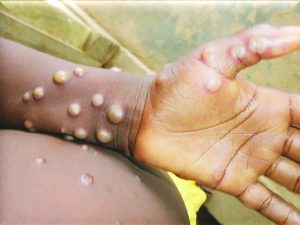Home News Borders, ports being monitored amid rising monkeypox cases in Brazil
In light of the rising cases of monkeypox in Brazil, Health Minister, Dr Frank Anthony stated that Guyana’s borders and ports of entry are being monitored for any potential case of the virus.
At the same time, Dr Anthony said every port should be manned for any sign of people travelling with the virus.
“We have to be careful because next door in Brazil, there is quite a number of cases, and given our open borders with Brazil, there can be persons who are infected coming across, and therefore, we can get cases. But it is not only that border. Monkeypox can come from any one of our ports of entry…Our doctors have been alerted and we look for certain signs and symptoms,” he outlined.
The Health Ministry has put contingency plans in place to cater for any cases of monkeypox, by repurposing a section of the Infectious Diseases Hospital at Liliendaal, Greater Georgetown.
There has been no reported case of monkeypox in Guyana thus far but the Health Ministry has been putting contingency plans in place as well as deploying resources to treat any cases that may arise.
According to the Health Minister, a section of the Ocean View facility has been prepared to treat monkeypox cases.
“We have already identified a section and with monkeypox, we have a number of measures already taken. We have developed guidelines for the treatment of monkeypox. We have laboratory people being trained to do the diagnostics. We have brought in the reagents to do PCR tests for monkeypox,” he noted.
Despite having a lower COVID hospitalisation, the Infectious Diseases Hospital is still fully operational. There is capacity of 198 patients, with a 52-bed capacity.
Dr Anthony noted that other infectious diseases have been treated at the facility, now that the COVID hospitalisation rate is low.
“We have to maintain the operations of the hospital because the systems that we have put in place is to make sure that we have centralised oxygen and therefore, we have to maintain the entire hospital.”
“What we have been doing is for other infectious diseases that we normally would monitor on a routine basis, when we have patients who display severe symptoms and need hospitalisation, we’re able to keep them in that hospital. It’s a rather big facility and there are rooms where people can be properly placed where they would not affect others,” he added.
Monkeypox would appear as a rash. From the time a person is exposed to the signs of infections, it will take approximately five to 13 days but can continue for up to 21 days.
The acute skin rash may be present with maculopapular (flat-based lesions) to vesicles (fluid-filled blisters), pustules, and subsequent crusting affecting the face, palms of the hand, soles of the feet, and the rest of the body.
It may be accompanied by headache, acute onset of fever, myalgia, back pain, asthenia, and lymphadenopathy. Monkeypox virus is transmitted from one person to another by close contact with lesions, body fluids, respiratory droplets and contaminated materials such as bedding.
Presently, antiretroviral treatment is used but it is not widely available around the world. Guyana is also making attempts to procure some smallpox vaccines, which have been used to treat monkeypox.
